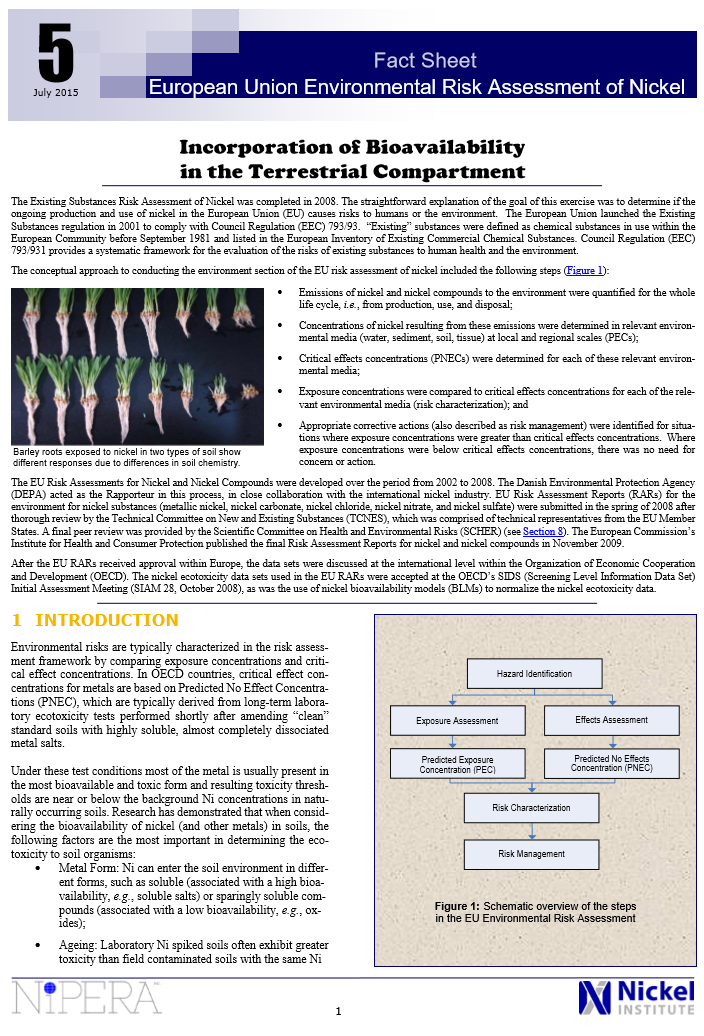The correction for bioavailability is applied to the effect concentrations [No Observed Effects Concentration (NOEC) and 10% Effects Concentration (EC10)] in the nickel terrestrial toxicity database (see Fact Sheet 2). The steps below need to be accomplished in order to incorporate bioavailability for the derivation of bioavailability-based PNECs of Ni for the terrestrial compartment for use in risk characterization (Figure 6).
In the first step, the added Ni toxicity values, i.e., [Ni]added3, are calculated by subtracting the Ni background concentration (Cb) in the test media from the reported total toxicity values, i.e., [Ni]total.
In the second step the [Ni]added toxicity values are corrected for the difference in Ni bioavailability between laboratory conditions (Ni freshly added as soluble salts) and field conditions, through the application of the L/A factor4. Because the background concentration is assumed to be already aged, the pH dependent L/A factor should only be applied to the [Ni]added which result in [Ni]aged, added5 values. The individual Ni background concentration (Cb) from the control soil is subsequently added to the [Ni]aged, added values resulting in an [Ni]aged, total6 (= [Ni]aged, added + Cb). The derivation and application of the L/A factor is discussed in Section 2.1.
The third step is the correction of the [Ni]aged, total values towards the specific soil properties of a given site, since it is demonstrated that abiotic factors (i.e., soil properties) affect Ni toxicity in soil. This normalization is based on the slopes of the organism specific regression models between toxicity thresholds and the driving abiotic factor (i.e., eCEC). This approach is discussed in Section 2.2 and result in the calculation of [Ni]normalized, aged, total7.
Subsequently, these [Ni]normalized, aged, total concentrations are further used to calculate the PNECnormalized, aged, total8 values according to the approach described in Fact Sheet 2.
Incorporation of the bioavailability concept as described above will result in the derivation of different Species Sensitivity Distributions (SSDs) and PNEC values, depending on the physicochemical characteristics (eCEC) of the terrestrial environments under assessment.
An overview of the SSDs derived for the different selected soil eco-regions in Europe as defined in Fact Sheet 2 is provided in Figure 7.
The soil physico-chemistry and median HC5 and PNEC values calculated for the different selected eco-regions in EU soils are summarized in Table 3.
3 [Ni]added = Ni concentrations in the soils beyond which toxicity occurs after subtraction of the Ni background in the test medium.
4 The L/A factor could be derived from the following empirical chemical model as, i.e., L/A = 1 + exp (1.4(pH-7.0)3. This equation is calibrated on soil aged maximally 1.5 year and soil pH ranged between pH 3.6 and 7.7. This empirical model predicts almost no ageing (L/A < 1.2) up to pH 6 and L/A = 2 at pH 7.0 and L/A = 3 at pH 7.5.
5 [Ni]aged, added = Ni concentrations in the soils beyond which toxicity occurs after subtraction of the Ni background in the test medium and correction for the L/A effect.
6 [Ni]aged, total = Ni concentrations in the soils beyond which toxicity occurs after correction for the L/A and addition of the Ni background in the test medium.
7 [Ni]normalized, aged, total = Ni concentrations in the soils beyond which toxicity occurs after correction for the L/A and normalization for differences in toxicity between different soil types.
8 PNECnormalized, aged, total = integration of aged and normalized EC10/NOEC values from the terrestrial Ni toxicity database via the SSD (see Fact Sheet 2).

